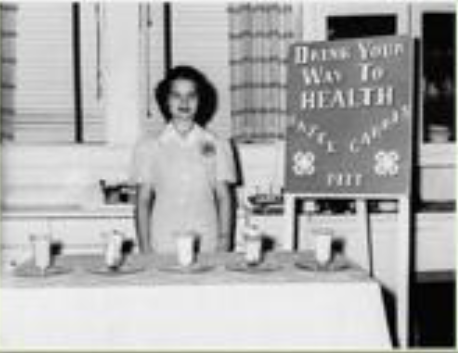Home Demonstration
During the Depression, in the 1930s, Stafford women learned how to extend food by cooking wisely and making their own clothes with home demonstration teams from Virginia Polytechnic Institute (known today as Virginia Tech). During World War II, Stafford women were led again by Home Demonstration and extension agents in programs to increase food production. Women that stayed on the farms had to tend livestock, drive tractors, and make certain that their farms kept producing food. Women across Stafford had their “Victory Gardens.” 4-H Clubs aided the war effort as Home Demonstrations showed ladies how to can and freeze, preserve fruits, vegetables, and meats. They also showed them how to sew their family’s clothes using patterns. This was the time when woodburning cookstoves were being replaced by electric ranges and refrigerators were used in place of iceboxes. Home Demonstration agents would even go to individual homes to help women use appliances the correct way. In 1943, 4-H club members began participating in the national “Feed a Fighter” campaign. Endorsed by President Franklin D. Roosevelt, it consisted of projects to produce the amount of food needed for one serviceman for one year. They included feeding lambs, feeding and handling one milk cow, growing 110 bushels of tomatoes, and canning 500 quarts of vegetables. Marion Brooks Robinson said that Mrs. Marie Heflin from Hartwood demonstrated cooking and sewing in Falmouth. She met in the Odd Fellows Lodge on Washington Street. (It was a frame house that is no longer standing which was located by the concrete bridge at the bottom of the hill.) In North Stafford, Jo Sanford Perry was a Home Demonstration agent who ran mattress making classes. Prior to a class, she handed out a list of materials the ladies would need to complete a mattress. A large pillow case looking mattress shell would be filled with stuffing. Buttons would be placed throughout the exterior of the mattress to keep the stuffing in place. Long needles were used to sew through the mattress and secure the buttons. Mrs. Perry held her classes at the Garrisonville Community Center which was located on the corner of Onville and Garrisonville Roads, where the CVS is located today. Sometimes she would hold classes in individual homes. She stressed a correct diet for good health.
Information from Marion Brooks Robinson, Mary Cary Kendall and Jerrilynn Eby MacGregor

